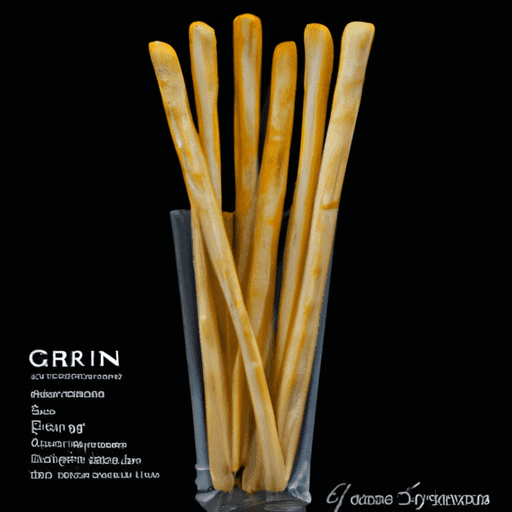The Delightful Crunch of Grissini Breadsticks
If you’re a fan of Italian cuisine, chances are you’ve come across the slender and crunchy goodness of grissini breadsticks. These delightful snack companions have been gracing our tables for centuries, adding a touch of elegance to any meal. In this post, we’ll dive into the world of grissini and explore their taste, versatility, nutritional value, and some interesting historical tidbits.
A Bite of Italian Elegance
Grissini breadsticks originate from the Piedmont region of Italy, where they have been a staple of Italian dining since the 17th century. Traditionally made with just flour, water, salt, and olive oil, these slender sticks of dough are stretched and twisted by hand before being baked to perfection.
The taste of grissini is a treat for the senses. The breadsticks offer a satisfying crunch with every bite, while their subtly salty flavor beautifully complements a wide range of dips, spreads, and cheeses. Whether you’re enjoying a cozy Italian dinner, hosting a cocktail party, or simply looking for a savory snack, grissini breadsticks are a perfect choice.
Versatile in the Kitchen
Grissini breadsticks are more than just an accompaniment to antipasti platters. These versatile sticks can be used in a variety of culinary creations. They can be served alongside soups and salads, adding a delightful textural contrast. Wrapped with prosciutto or thinly sliced cured meats, grissini become an irresistible appetizer or a charming addition to a charcuterie board. You can even get creative and incorporate them into hors d’oeuvres by pushing them into bite-sized pieces of cheese or vegetables.
Their long and slender shape makes grissini an elegant alternative to regular bread or crackers. They bring a touch of sophistication to any table, elevating the dining experience and delighting guests with their unique shape and crisp texture.
Nutritional Value
When it comes to nutritional value, grissini breadsticks are relatively light and low in fat compared to other snacks. They provide a moderate amount of carbohydrates and proteins, making them a satisfying and energizing option for those in need of a quick pick-me-up. Their simple ingredient list ensures that they contain no unnecessary additives or preservatives, making them a healthier alternative to some mainstream snack options.
That said, it’s important to enjoy grissini breadsticks in moderation. While they can be a part of a balanced diet, portion control is key, particularly for those watching their carbohydrate or calorie intake.
A Historical Connection
Grissini breadsticks have a fascinating history that can be traced back to the 17th century, when they were created to address the digestive issues of the young Duke of Savoy, Vittorio Amedeo II. The Duke’s doctors believed that long and thin breadsticks would be easier for him to digest. Grissini were born out of this need and quickly gained popularity, spreading throughout Italy and beyond.
Over time, grissini evolved from a medical necessity to a beloved culinary tradition. Today, they continue to be a symbol of Italian gastronomy, loved by people around the world.
Conclusion
Grissini breadsticks are a delightful and versatile addition to any culinary experience. Their satisfying crunch, subtle flavor, and elegant shape make them a beloved companion to a variety of dishes, from antipasti platters to charcuterie boards. With their centuries-old history and cultural significance, grissini breadsticks are more than just a snack — they are a taste of Italian traditions.
So the next time you’re craving a bit of Italian elegance or searching for a perfect accompaniment to your favorite dips and spreads, reach for a handful of grissini breadsticks. Let their slender form and delightful crunch transport you to the romantic streets of Italy, where simple pleasures like these have stood the test of time.
Grissini Breadsticks
Origin: Grissini breadsticks, also known as grissino or grissini Torinesi, originated in Italy. They are believed to have originated in the city of Turin in the Piedmont region during the 17th century.
Common Uses: Grissini breadsticks are commonly served as an appetizer or snack. They are often enjoyed alongside antipasti, soups, or salads. Grissini can also be used as a garnish for certain dishes, such as wrapping them with prosciutto or serving them with dips and spreads.
Nutritional Benefits: Grissini breadsticks are known for their low fat content and are often considered a healthier alternative to other bread products. They are typically made from flour, water, yeast, and salt, resulting in a relatively simple and natural ingredient list.
Unique Properties: Grissini breadsticks are characterized by their thin and elongated shape, with a crunchy texture. The dough is rolled out into thin strands and baked until crisp. They can vary in length and thickness depending on regional preferences. Traditional grissini are usually plain, but various flavors such as sesame, rosemary, or poppy seeds can be added for additional taste.
Historical Significance: Grissini breadsticks were originally created as a substitute for bread during times when bread regulations were more strict. They were a way for bakers to circumvent the regulations that limited the size and shape of bread loaves. Over time, grissini became popular across Italy and eventually gained international recognition as a classic Italian snack.




Use the share button below if you liked it.
It makes me smile, when I see it.